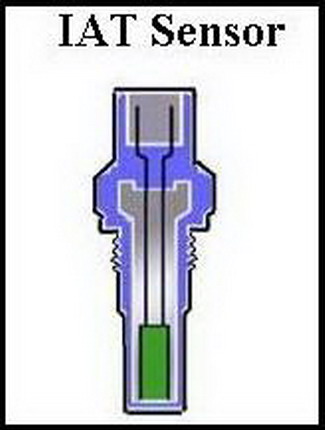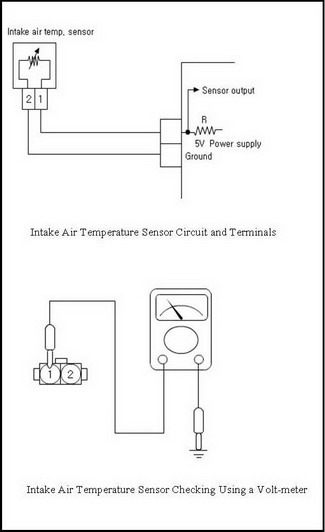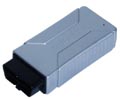- Temperature Sensor
- |
- Sensors
- |
- Repair Basics
- |
- Technical Info
- |
- Car Tech Info
- |
- MicroTronik
Temperature Sensor

Intake Air Temperature

IAT check
The measuring temperature range and characteristic vary depending on constituting substances of thermistor.
- Coolant temperature sensor is installed for thermistor part to contact with flowing coolant at cylinder block water jacket.
- Intake air temperature sensor is installed at surge tank, with the thermistor part of the sensor contacting with intake air. As these two sensors (IAT & MAP) are installed at the same part and have functionally associated with each other, they are sometimes integrated together and installed as a part.
(1) Circuit Configuration and Terminal:
The Input voltage of 5V is provided to terminal B and resistance R is installed inside ECM.(2) Checking Procedure:
When using volt-meter, turn on terminal ignition switch and measure the voltage, and then compare with specified value. As NTC thermistor type is used, higher temperature will reduce output voltage. Otherwise disconnect connector and check if supply voltage of 5V is operating normally at harness side. In addition check for circuit break and short.And you can do the same for checking the Coolant Temperature Sensor.
(3) Troubleshooting:
- For troubleshooting of intake temperature sensor, resistance value and output voltage change by temperature variation are used for diagnosis. And connector connection and break and short shall be checked as well.
- For checking a separate part, use similar device generating hot air (ex. Hair dryer, etc) to measure resistance value and output voltage change by temperature variation.
Then if resistance value does not change by temperature variation, it will indicate sensor failure. Replace the sensor.
(4) Failure Symptom:
Intake temperature sensor:- Ignition timing correction may be impossible and generate knocking.
- Acceleration is poor during running.
- Higher fuel consumption.
- Poor start-up and engine malfunction during idling after start-up.
- Sudden engine stop during idling or running.
- Higher fuel consumption and higher emission of CO and HC.
Changing Dmaged DME in F Series
Description
Temperature sensors used for engine control include coolant temperature sensor, intake air temperature sensor,and it is failure may cause fault codes in the Car ECU , and malfunctions with the the whole cars systems.
Autohex II Reviews
AutoHex II
AutoHex II is your best choice to have full access to dealer functions like coding, adjusting and modules flashing/programming, Contact us for prices
AutoHex Forum


